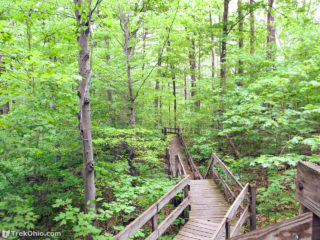 Howard Collier is a 115-acre state nature preserve located in Seneca County in northwestern Ohio. The preserve is named after a former state budget director who was instrumental in allocating funds for the acquisition of park land. The Collier preserve features a loop trail with an impressive staircase/boardwalk that leads down into the flood plain. The Sandusky River can be viewed from a couple of short side trails off the loop. There is also one more extensive side trail that leads to a township Read more ➜
Howard Collier is a 115-acre state nature preserve located in Seneca County in northwestern Ohio. The preserve is named after a former state budget director who was instrumental in allocating funds for the acquisition of park land. The Collier preserve features a loop trail with an impressive staircase/boardwalk that leads down into the flood plain. The Sandusky River can be viewed from a couple of short side trails off the loop. There is also one more extensive side trail that leads to a township Read more ➜ Howard Collier State Nature Preserve
 Howard Collier is a 115-acre state nature preserve located in Seneca County in northwestern Ohio. The preserve is named after a former state budget director who was instrumental in allocating funds for the acquisition of park land. The Collier preserve features a loop trail with an impressive staircase/boardwalk that leads down into the flood plain. The Sandusky River can be viewed from a couple of short side trails off the loop. There is also one more extensive side trail that leads to a township Read more ➜
Howard Collier is a 115-acre state nature preserve located in Seneca County in northwestern Ohio. The preserve is named after a former state budget director who was instrumental in allocating funds for the acquisition of park land. The Collier preserve features a loop trail with an impressive staircase/boardwalk that leads down into the flood plain. The Sandusky River can be viewed from a couple of short side trails off the loop. There is also one more extensive side trail that leads to a township Read more ➜ 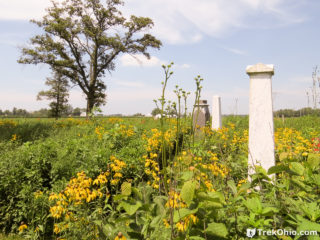 Last summer we visited two of Ohio's smallest state nature preserves: Bigelow Cemetery and Smith Cemetery. Within these two preserves are remnants of prairie that once extended over 5% of Ohio. Because both sites were 19th century cemeteries, they were undisturbed by the plowing that converted 99% of this rich, prairie soil into Ohio farmland. Today I will discuss the half-acre Bigelow Cemetery State Nature Preserve, and I'll save the nearby Smith Cemetery State Nature Preserve for a later post.
Last summer we visited two of Ohio's smallest state nature preserves: Bigelow Cemetery and Smith Cemetery. Within these two preserves are remnants of prairie that once extended over 5% of Ohio. Because both sites were 19th century cemeteries, they were undisturbed by the plowing that converted 99% of this rich, prairie soil into Ohio farmland. Today I will discuss the half-acre Bigelow Cemetery State Nature Preserve, and I'll save the nearby Smith Cemetery State Nature Preserve for a later post. 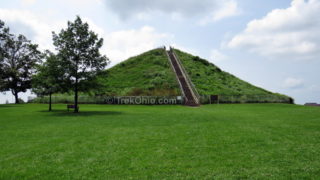 No one knows the their name. They left no written record. Today we call them the Adena Culture and we know they had a thriving civilization in Ohio between 1000 BC and 200 BC. They built hundreds of earthen mounds, probably as part of a funeral ritual. The largest of these mounds is a 65 foot tall mound situated on a hill overlooking the Miami River in Miamisburg, OH.
The mound was partially excavated and a bark covered skeleton was discovered. The Miamisburg mound has never been
No one knows the their name. They left no written record. Today we call them the Adena Culture and we know they had a thriving civilization in Ohio between 1000 BC and 200 BC. They built hundreds of earthen mounds, probably as part of a funeral ritual. The largest of these mounds is a 65 foot tall mound situated on a hill overlooking the Miami River in Miamisburg, OH.
The mound was partially excavated and a bark covered skeleton was discovered. The Miamisburg mound has never been 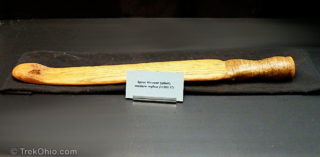 While attending the Ohio Pawpaw Festival in Athens, I got the opportunity to try out an ancient weapon — the atlatl. The atlatl is also known as a spear thrower; although, today the spear is referred to as a dart. Since the dart is fletched with feathers, it looks a like a really long arrow. The atlatl was used by the earliest Paleoindian cultures in Ohio. It continued to be the primary weapon of Native Americans in Ohio until it was displaced by the bow and arrow in the late woodland period.
To
While attending the Ohio Pawpaw Festival in Athens, I got the opportunity to try out an ancient weapon — the atlatl. The atlatl is also known as a spear thrower; although, today the spear is referred to as a dart. Since the dart is fletched with feathers, it looks a like a really long arrow. The atlatl was used by the earliest Paleoindian cultures in Ohio. It continued to be the primary weapon of Native Americans in Ohio until it was displaced by the bow and arrow in the late woodland period.
To 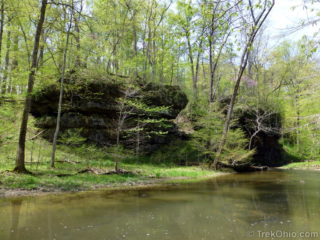 Two thousand years ago, the Hopewell people built a massive earthwork enclosing a 40-acre hilltop in southwest Ohio. This earthwork which resembles a fort was later dubbed Fort Hill.
Today Fort Hill is a 1,200 acre preserve owned by the Ohio Historical Society and operated by the Arc of Appalachia Preserve System. The preserve features 11 miles of hiking trails, a small museum, a parking area, picnic shelters, and rest rooms.
Fort Trail
We visited the preserve last September
Two thousand years ago, the Hopewell people built a massive earthwork enclosing a 40-acre hilltop in southwest Ohio. This earthwork which resembles a fort was later dubbed Fort Hill.
Today Fort Hill is a 1,200 acre preserve owned by the Ohio Historical Society and operated by the Arc of Appalachia Preserve System. The preserve features 11 miles of hiking trails, a small museum, a parking area, picnic shelters, and rest rooms.
Fort Trail
We visited the preserve last September 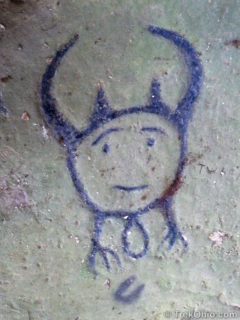 The Petroglyphs
The Leo Petroglyph State Memorial is a site with about 37 petroglyphs (line drawings carved in stone). The petroglyphs were made on an outcropping of bedrock consisting of Black Hand sandstone. Based on the weathering of the exposed sandstone, it is believed that the carvings are about 700 years old. That age would make them the handiwork of the Fort Ancient Indians, a late prehistoric culture that was active in Ohio from about 1000 A.D. to 1650 A.D.
I wasn't sure exactly what
The Petroglyphs
The Leo Petroglyph State Memorial is a site with about 37 petroglyphs (line drawings carved in stone). The petroglyphs were made on an outcropping of bedrock consisting of Black Hand sandstone. Based on the weathering of the exposed sandstone, it is believed that the carvings are about 700 years old. That age would make them the handiwork of the Fort Ancient Indians, a late prehistoric culture that was active in Ohio from about 1000 A.D. to 1650 A.D.
I wasn't sure exactly what 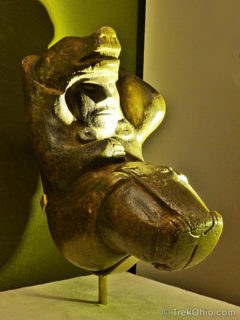 When looking at the prehistoric artefacts and earthen structures in Ohio, I'm always wondering what meanings these things held for the people who created them. I end up reading whatever explanatory sign is posted nearby, but while I'm doing so I'm also wondering how anthropologists know any of this stuff. Since prehistoric societies don't leave any texts explaining themselves or their culture, anthropologists have to be making a lot of inferences.
However when I was at Serpent Mound
When looking at the prehistoric artefacts and earthen structures in Ohio, I'm always wondering what meanings these things held for the people who created them. I end up reading whatever explanatory sign is posted nearby, but while I'm doing so I'm also wondering how anthropologists know any of this stuff. Since prehistoric societies don't leave any texts explaining themselves or their culture, anthropologists have to be making a lot of inferences.
However when I was at Serpent Mound 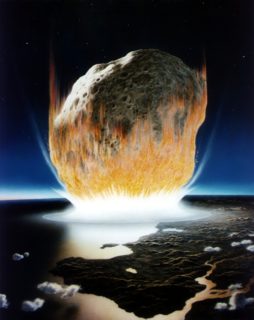 A huge rock hurtles through the empty void of space. Its been orbiting the sun for hundreds of millions of years. But this orbit will be different. This time its trajectory and the orbit of earth intersect. It will impact somewhere in southern Ohio releasing energy equivalent to a large thermonuclear weapon and creating a crater five miles across. Alert the governor, start evacuations! But wait, it's already too late!
It's too late because the impact occurred during the Permian Period
A huge rock hurtles through the empty void of space. Its been orbiting the sun for hundreds of millions of years. But this orbit will be different. This time its trajectory and the orbit of earth intersect. It will impact somewhere in southern Ohio releasing energy equivalent to a large thermonuclear weapon and creating a crater five miles across. Alert the governor, start evacuations! But wait, it's already too late!
It's too late because the impact occurred during the Permian Period 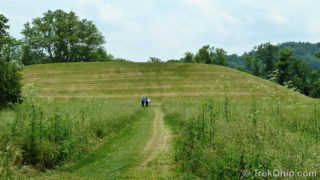 Seip Mound State Memorial Park is one of the five noncontiguous sites that make up the Hopewell Culture National Historical Park. The other four sites are Hopeton Earthworks, Hopewell Mound Group, High Banks Works, and the Mound City Group (reviewed by us here). Native Americans belonging to the Hopewell tradition constructed this mound sometime between 100 B.C. – A.D. 400.
The mound pictured above was part of a larger earthworks complex. At a number of sites in Ohio, Native Americans
Seip Mound State Memorial Park is one of the five noncontiguous sites that make up the Hopewell Culture National Historical Park. The other four sites are Hopeton Earthworks, Hopewell Mound Group, High Banks Works, and the Mound City Group (reviewed by us here). Native Americans belonging to the Hopewell tradition constructed this mound sometime between 100 B.C. – A.D. 400.
The mound pictured above was part of a larger earthworks complex. At a number of sites in Ohio, Native Americans 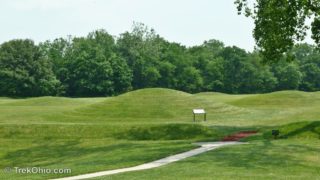 What's known as the "Mound City Group" is part of the Hopewell Culture National Historical Park in Ross County, Ohio. This land was used for funeral rituals by a Native American civilization that flourished between 200 B.C. and 500 A.D. Mound City is approximately 13 acres in size. A low earthen wall about 3 to 4 feet high (1 to 1.3 meters) lies around the perimeter; it's shape is that of a square with rounded corners. Perhaps the builders of the Mound City thought of the wall as a "sacred enclosure"
What's known as the "Mound City Group" is part of the Hopewell Culture National Historical Park in Ross County, Ohio. This land was used for funeral rituals by a Native American civilization that flourished between 200 B.C. and 500 A.D. Mound City is approximately 13 acres in size. A low earthen wall about 3 to 4 feet high (1 to 1.3 meters) lies around the perimeter; it's shape is that of a square with rounded corners. Perhaps the builders of the Mound City thought of the wall as a "sacred enclosure"